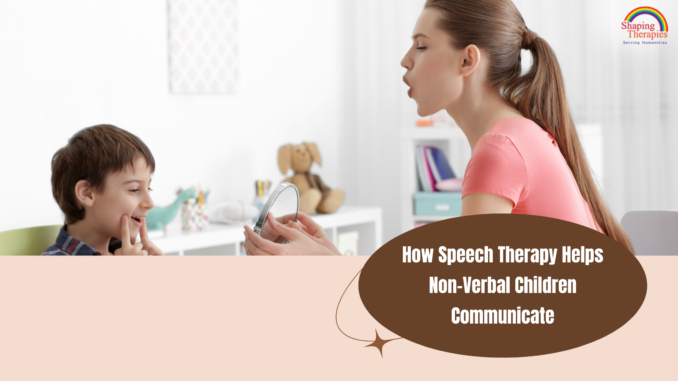
I. Introduction
Imagine a parent watching their child struggle to express even the simplest needs. It can be overwhelming when your child remains non-verbal while others around them start talking.
Communication is more than just spoken words—it’s about connecting with the world. For non-verbal children, this connection can be challenging, but speech therapy offers hope. Through specialized techniques and alternative communication methods, non-verbal children can express themselves effectively.
For parents, caregivers, educators, and therapists, understanding how speech therapy can empower non-verbal children is crucial for fostering communication and emotional growth.
II. Understanding Non-Verbal Communication in Children
- What Does It Mean to Be Non-Verbal?
A non-verbal child is one who has limited or no spoken language. This doesn’t mean they don’t understand or want to communicate—it simply means they need alternative ways to express themselves.
- Why Are Some Children Non-Verbal?
Common reasons a child may be non-verbal include: - Autism Spectrum Disorder (ASD)
- Developmental Delays
- Apraxia of Speech
- Genetic Conditions
- Hearing Impairments
- Why Communication Matters
Communication is essential for social interaction, learning, and emotional well-being. Without the ability to express their thoughts and needs, non-verbal children may experience frustration and behavioral challenges.
III. The Role of Speech Therapy for Non-Verbal Children
Speech therapy plays a vital role in helping non-verbal children develop communication skills through a comprehensive and personalized approach.
How Speech Therapy Works:
- Comprehensive Assessment: A Speech-Language Pathologist (SLP) evaluates the child’s speech, understanding, and non-verbal abilities.
- Personalized Treatment Plans: Therapy is customized based on the child’s strengths and communication goals.
- Augmentative and Alternative Communication (AAC): Speech therapists introduce tools to aid communication.
Goals of Speech Therapy for Non-Verbal Children
- Enhance communication abilities
- Develop alternative communication methods
- Improve social interaction and confidence
IV. Key Strategies and Techniques Used in Speech Therapy
Speech therapists use a range of effective techniques to support non-verbal children, helping them develop alternative ways to communicate. These strategies are tailored to meet each child’s unique needs and abilities.
1. Picture Exchange Communication System (PECS): This method allows children to exchange pictures to request items or express needs. It promotes independent communication by providing a simple and visual way to convey thoughts.
2. Sign Language: Sign language uses hand signs to represent words and concepts, offering a non-verbal way to communicate. It is accessible and helps in developing early language skills for children who struggle with speech.
3. Speech-Generating Devices (SGDs): These devices produce spoken words from typed or selected inputs, allowing non-verbal children to communicate effectively. SGDs range from dedicated devices to tablet-based applications that support diverse communication needs.
4. Visual Supports: Visual aids like schedules and picture boards help children understand routines and expectations. They reduce anxiety by providing a predictable structure, making daily transitions smoother.
5. Gestures and Body Language: Encouraging natural gestures helps children express their needs and feelings. Speech therapists also work on developing intentional gestures, enhancing a child’s ability to communicate without words.
6. Object-Based Communication: This method uses real objects to represent requests or activities, making communication tangible. It is particularly beneficial for children with sensory sensitivities who respond better to physical cues.
7. Aided Language Stimulation (ALS): Caregivers and therapists model the use of AAC (Augmentative and Alternative Communication) systems during interactions. Regular modeling helps children understand and use these systems more effectively over time.
8. Sensory Integration Activities: These activities address sensory processing challenges that may affect communication. By regulating sensory input, therapy helps children focus better and engage more effectively in communication tasks.
V. Benefits of Speech Therapy for Non-Verbal Children
- Increased Ability to Express Needs: Reduces frustration and enhances independence.
- Enhanced Social Interaction: Enables connection with peers and family.
- Improved Understanding of Language: Strengthens comprehension skills.
- Greater Independence: Empowers children to engage in everyday activities.
- Emergent Verbal Communication: Some children may eventually develop spoken language.
- Boosted Confidence: Feeling understood enhances self-esteem.
VI. The Role of Parents and Caregivers in Supporting Communication
Parents and caregivers play a critical role in supporting their child’s communication journey.
1. Consistency is Key: Use communication tools across all settings—home, school, and therapy.
2. Create Communication Opportunities: Encourage choices during daily routines.
3. Respond to All Communication Attempts: Acknowledge both verbal and non-verbal efforts.
4. Collaborate with the Speech Therapist: Share progress and concerns regularly.
5. Practice Patience: Celebrate small victories and provide ongoing encouragement.
VII. Finding Speech Therapy Services for Non-Verbal Children
If you suspect your child has communication challenges, early intervention is crucial.
– Where to Start:
- Consult your pediatrician for referrals.
- Reach out to speech therapy centres like Shaping Therapies, Powai for expert support.
– Choosing the Right Speech Therapist: - Look for experience with non-verbal children and AAC systems.
- Ask about their approach and involvement of parents in the therapy process.
At Shaping Therapies, Powai, experienced speech therapists use innovative and personalized methods to help non-verbal children thrive. Their comprehensive assessments and tailored interventions empower families to navigate the communication journey effectively.
VIII. Conclusion
Recognizing and addressing non-verbal communication challenges early can significantly improve a child’s ability to express themselves.
- Recap of Key Strategies: Techniques like PECS, AAC, and sign language offer practical ways for children to communicate.
- Empowerment Message: With the right support from professionals like those at Shaping Therapies, Powai, every child can find a way to connect with the world.
- Hopeful Outlook: Speech therapy opens doors to new possibilities, fostering independence and confidence in non-verbal children.
If you’re concerned about your child’s communication development, contact a qualified speech therapist today. Shaping Therapies, Powai is here to guide you through this important journey.

Leave a Reply